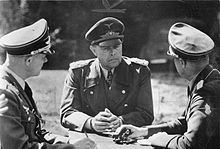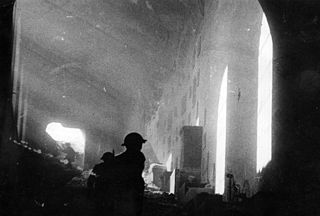
The Battle of Monte Cassino, also known as the Battle for Rome, was a series of four military assaults by the Allies against German forces in Italy during the Italian Campaign of World War II. The objective was to break through the Winter Line and facilitate an advance towards Rome.
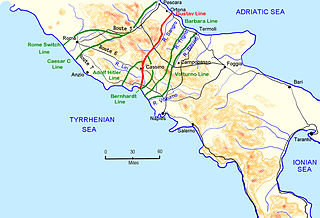
During the Italian Campaign of World War II, the Barbara Line was a series of German military fortifications in Italy, some 10–20 mi (16–32 km) south of the Gustav Line, from Colli al Volturno to the Adriatic Coast in San Salvo and a similar distance north of the Volturno Line. Near the eastern coast, it ran along the line of the Trigno river. The line mostly consisted of fortified hilltop positions. The line was broken by the allied army in November 1943 following which the Axis forces withdrew to the defensible positions of the Winter Line.

The Bernhardt Line, or Reinhard Line, was a German Army defensive line in Italy during the Italian Campaign of World War II. Having reached the Bernhardt Line at the start of December 1943, it took until mid-January 1944 for the US Fifth Army to fight its way to the next line of defences, the Gustav Line. The Bernhardt Line was defended by XIV Panzer Corps, part of the German Tenth Army.

Operation Avalanche was the codename for the Allied landings near the port of Salerno, executed on 9 September 1943, part of the Allied invasion of Italy during World War II. The Italians withdrew from the war the day before the invasion, but the Allies landed in an area defended by German troops. Planned under the name Top Hat, it was supported by the deception plan Operation Boardman.

The Allied invasion of Italy was the Allied amphibious landing on mainland Italy that took place from 3 September 1943, during the Italian campaign of World War II. The operation was undertaken by General Sir Harold Alexander's 15th Army Group and followed the successful Allied invasion of Sicily. The main invasion force landed on the west coast of Italy at Salerno on 9 September as part of Operation Avalanche, while two supporting operations took place in Calabria and Taranto.

The Gothic Line was a German and Italian defensive line of the Italian Campaign of World War II. It formed Field Marshal Albert Kesselring's last major line of defence along the summits of the northern part of the Apennine Mountains during the fighting retreat of the Axis forces in Italy against the Allied Armies in Italy, commanded by General Sir Harold Alexander.

The Tunisian campaign was a series of battles that took place in Tunisia during the North African campaign of the Second World War, between Axis and Allied forces from 17 November 1942 to 13 May 1943. The Allies consisted of British Imperial Forces, including a Greek contingent, with American and French corps. The campaign opened with initial success by the German and Italian forces but the massive supply interdiction efforts led to the decisive defeat of the Axis. Over 260,000 German and Italian troops were taken as prisoners of war, including most of the Afrika Korps.
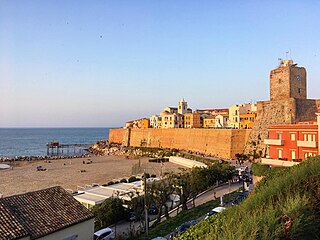
Termoli is a comune (municipality) on the south Adriatic coast of Italy, in the province of Campobasso, region of Molise. It has a population of around 32,000, having expanded quickly after World War II, and it is a local resort town known for its beaches and old fortifications. Once it was known only as a fishing port, but in the new millennium it is a favourite resort for Italian families. In Termoli we can find the only port of the region. There is also a strong competition with the province, Campobasso, in fact some of the “termolesi” like to say that Termoli is province-less

The Battle of Gazala, also the Gazala Offensive was fought near the village of Gazala during the Western Desert Campaign of the Second World War, west of the port of Tobruk in Libya, from 26 May to 21 June 1942. Axis troops of the Panzerarmee Afrika consisting of German and Italian units fought the British Eighth Army composed mainly of British Commonwealth, Indian and Free French troops.

Sir John Anthony Holt Saunders, CBE, DSO, MC was chairman of The Hongkong and Shanghai Banking Corporation, at a time of rapid and turbulent development of the Hong Kong economy. In his banking career, as chief manager from 1962, and chairman from 1964 to 1972, Saunders was at the helm of Hong Kong's most important financial institution at a time when the Crown Colony was rapidly changing from a trading post to a regional centre of manufacturing and finance.

The 78th Infantry Division, also known as the Battleaxe Division, was an infantry division of the British Army, raised during the Second World War that fought, with great distinction, in Tunisia, Sicily and Italy from late 1942–1945.

The 22nd Armoured Brigade was an armoured brigade of the British Army that saw service during and after the Second World War. The brigade was formed on the outbreak of war on 3 September 1939 from Territorial Army (TA) armoured regiments. It saw a considerable amount of action during the war, beginning with the Western Desert Campaign where it was engaged in Operation Crusader and at the Battles of Gazala, Mersa Matruh, First Alamein and Alam el Halfa. It then joined the 7th Armoured Division for the Second Battle of El Alamein. It remained part of 7th Armoured for the rest of the war, including the campaigns in Tunisia, Italy and North West Europe. It continued in the postwar TA until 1956. The brigade's identity was re-established in the Regular Army between 1981 and 1993.

The Battle of the Argenta Gap was an engagement which formed part of the Allied spring 1945 offensive during the Italian campaign in the final stages of the Second World War. It took place in northern Italy from 12 to 19 April 1945 between troops of British V Corps commanded by Lieutenant-General Charles Keightley and German units of LXXVI Panzer Corps commanded by Lieutenant General Gerhard von Schwerin.

The Battle of San Pietro Infine was a major engagement from 8–17 December 1943, in the Italian Campaign of World War II involving Allied forces attacking from the south against heavily fortified positions of the German "Winter Line" in and around the town of San Pietro Infine, just south of Monte Cassino about halfway between Naples and Rome.

The Trasimene Line was a German defensive line during the Italian Campaign of World War II. It was sometimes known as the Albert Line. The German Commander-in-Chief (C-in-C), Generalfeldmarschall Albert Kesselring, used the line to delay the Allied northward advance in Italy in mid June 1944 to buy time to withdraw troops to the Gothic Line and finalise the preparation of its defenses.
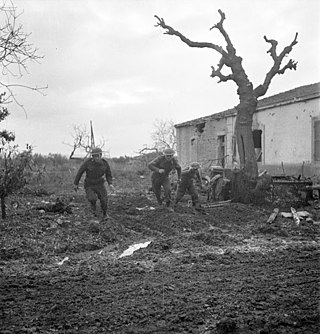
The Moro River campaign was an important battle of the Italian campaign during the Second World War, fought between elements of the British Eighth Army and LXXVI Panzer Corps of the German 10th Army. Lasting from 4 December 1943 to 4 January 1944, the campaign occurred primarily in the vicinity of the Moro River in eastern Italy. The campaign was designed as part of an offensive launched by General Sir Harold Alexander's Allied 15th Army Group, with the intention of breaching the German Army's Winter Line defensive system and advancing to Pescara—and eventually Rome.

The Spring 1945 offensive in Italy, codenamed Operation Grapeshot, was the final Allied attack during the Italian Campaign in the final stages of the Second World War. The attack in the Lombard Plain by the 15th Allied Army Group started on 6 April 1945 and ended on 2 May with the surrender of all Axis forces in Italy.

The Run for Tunis was part of the Tunisia Campaign which took place during November and December 1942 during the Second World War. Once French opposition to the Allied Operation Torch landings had ceased in mid-November, the Allies made a rapid advance by a division-sized force east from Algeria, to capture Tunis and forestall an Axis build up in Tunisia and narrowly failed. Some Allied troops were fewer than 20 miles (32 km) short of Tunis by late November but the defenders counter-attacked and pushed them back nearly 20 miles (32 km), to positions which had stabilised by the end of the year.
Operation Devon was the code name of an amphibious landing by British Commandos in 1943 at Termoli, on the Adriatic coast of Italy, during the Italian Campaign of World War II.

The 2nd Battle of Longstop Hill or the Capture of Longstop Hill took place in Tunisia during the Tunisia Campaign of World War II from 21 to 23 April 1943. The battle was fought for control over the heights of Djebel el Ahmera and Djebel Rhar, together known as Longstop Hill and vicinity, between the British forces of the First Army and German units of the 5th Panzer Army. The infantry of the 78th Battleaxe Division and Churchill tanks of the North Irish Horse captured Longstop Hill after bitter fighting, in which the tanks created a measure of tactical surprise by driving up the hill, a manoeuvre that only Churchill tanks could achieve. The attackers broke through the German defences, which were the last great natural barrier on the road to Tunis.

